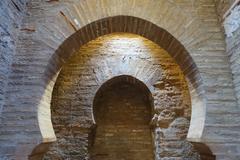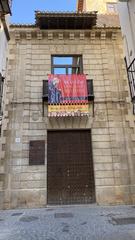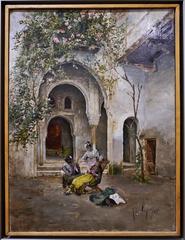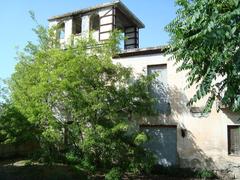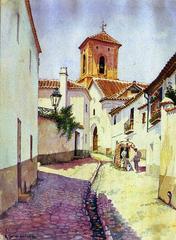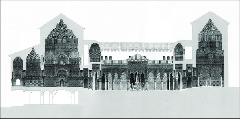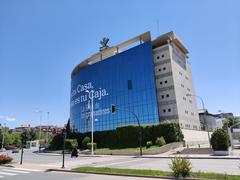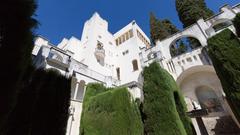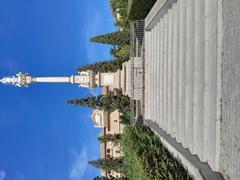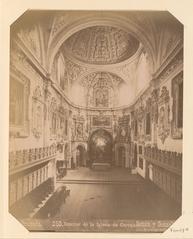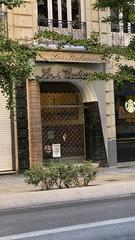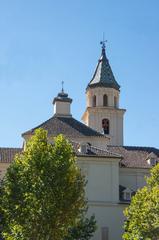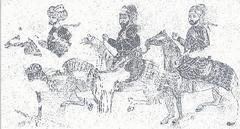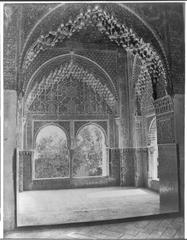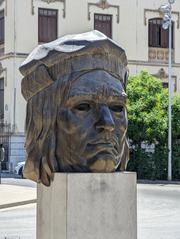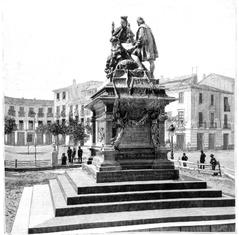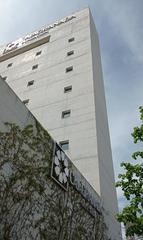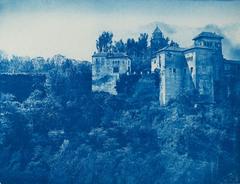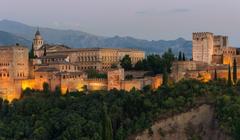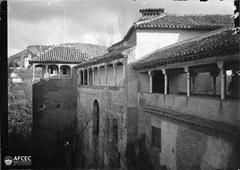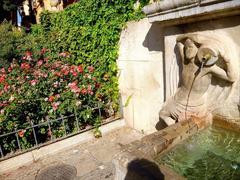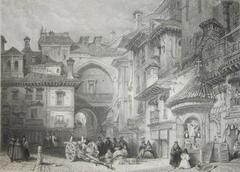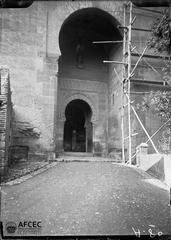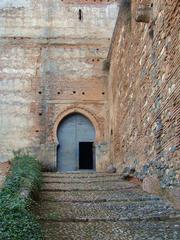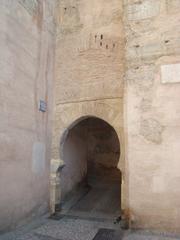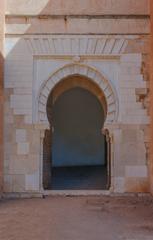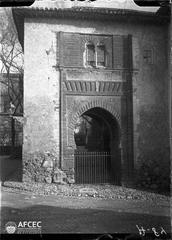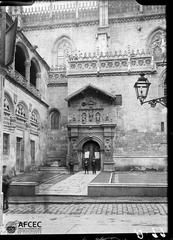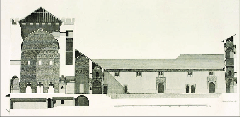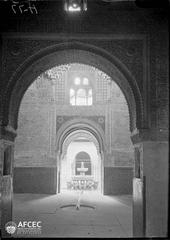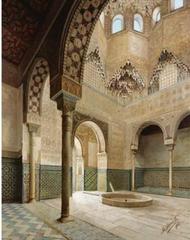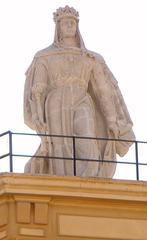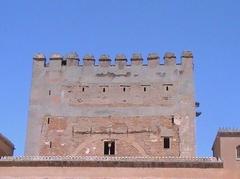
Real Maestranza de Caballería de Granada: Visiting Hours, Tickets, and Historical Significance Guide
Date: 04/07/2025
Introduction
Nestled in the heart of Granada, the Real Maestranza de Caballería de Granada is a living testament to Spain’s noble traditions, military history, and equestrian culture. Established in 1686, this distinguished brotherhood has played a vital role in shaping the city’s social and cultural identity. Its baroque headquarters, deep-rooted ceremonies, and enduring influence make it a must-visit site for history enthusiasts and cultural travelers alike. This guide offers a detailed look at the Maestranza’s origins, architectural features, historical significance, visiting information, and travel tips.
For official updates, always check the Granada Tourism, Caballeros San Juan de Dios, and Rincones de Granada websites.
Origins and Historical Foundation
The Real Maestranza de Caballería de Granada was founded in 1686 with royal approval from King Charles II. Its establishment followed the model of similar noble brotherhoods in Seville and Ronda, aiming to maintain the martial skills, horsemanship, and chivalric values of Granada’s aristocracy (Granada Tourism). The institution’s statutes emphasized loyalty to the monarchy and the Catholic faith, with members drawn from Granada’s most prominent families. Over centuries, the Maestranza has played a key role in local governance, military campaigns, and religious ceremonies, helping to weave the city’s noble heritage into its modern identity.
Architectural Evolution and Headquarters
The Maestranza’s headquarters, located on Calle Laurel de las Tablas, is a striking example of Andalusian baroque and early 20th-century civic architecture. The brick façade features heraldic shields and a classical loggia, representing the Fernández de Córdova family and the Counts of Luque (Rincones de Granada). Inside, visitors can admire ornate courtyards, ceremonial halls, and a library that preserves valuable manuscripts and documents.
Key architectural features:
- Grand stone portals adorned with the Maestranza’s coat of arms.
- Central Andalusian patio with arcaded galleries and natural light.
- Stucco, wrought-iron balconies, and artesonado wooden ceilings reflecting Mudéjar and Baroque influences (Casa Real).
- Heraldic decorations and ceremonial spaces filled with portraits, regalia, and historic artifacts.
The headquarters has been renovated over the centuries, balancing preservation with the evolving needs of the institution (Granada City Council).
Military, Social, and Cultural Roles
From its inception, the Maestranza was deeply involved in Spain’s military affairs. Members maintained horses, arms, and uniforms at their own expense and participated in drills and parades. During conflicts such as the War of Spanish Succession and the Peninsular War, the Maestranza contributed cavalry units to the royal armies (Andalucia.org).
Beyond military duties, the Maestranza fostered Granada’s social and cultural life by organizing tournaments, jousts, and equestrian exhibitions. These events reinforced the ideals of chivalry and the hierarchical structure of society, while also supporting religious festivals and charitable activities.
Equestrian and Bullfighting Traditions
The Maestranza’s close connection to equestrian arts is evident in its support for rider training, tournaments, and public exhibitions. While not primarily a bullfighting venue, it has sponsored and participated in events such as the “corrida de rejones,” where mounted bullfighters demonstrate their horsemanship (Granada Tourism). The lost Plaza de Toros de la Maestranza, built in the 18th century and destroyed in 1874, was a key site for these festivities (UAL).
Notable Members and Legacy
Over the years, the Maestranza has counted among its members illustrious figures such as the Fernández de Córdoba, Mendoza, and Zayas families. Notable members have distinguished themselves in military service, diplomacy, and the arts. The Marquis of Mondéjar, for example, played a leading role during the Napoleonic Wars, exemplifying the institution’s commitment to Spain’s defense and civic life.
Preservation and Modern Significance
Today, the Maestranza focuses on preserving its archives, promoting equestrian sports, and supporting cultural events. Collaborations with museums, universities, and heritage organizations help transmit its legacy to new generations. Recent updates to regulations reflect a commitment to inclusivity and modern cultural stewardship (europapress.es).
Religious and Festive Functions
The Maestranza participates actively in Granada’s religious calendar, particularly through annual masses at the Real Basílica de San Juan de Dios in honor of deceased members. It venerates the Immaculate Conception and Saint John of God, deepening its spiritual ties to the city (caballerossanjuandedios.org). Royal visits and major civic celebrations often feature processions and ceremonial events hosted by the Maestranza.
Social Influence and Philanthropy
As a cornerstone of Granada’s social fabric, the Maestranza supports scholarships, historical research, and community service projects. Its statutes emphasize ethical values and civic responsibility, and educational initiatives include public lectures, guided tours, and archival access for scholars.
Architectural Highlights at a Glance
- Location: Calle Laurel de las Tablas, Magdalena district, between Plaza de la Trinidad and Plaza de los Lobos
- Style: Early 20th-century brick façade, Andalusian baroque elements, heraldic shields, and loggia
- Key Spaces: Central patio, ceremonial halls, historic library, and archives
Visiting the Real Maestranza de Caballería de Granada: Hours, Tickets, and Tips
Location and Access
- Address: Calle Laurel de las Tablas, Magdalena district, Granada
- Nearby Landmarks: Monastery of San Jerónimo, Granada Cathedral, Alhambra, Albaicín district
- Accessibility: The building is wheelchair accessible, but visitors with mobility concerns should notify staff in advance.
Visiting Hours (as of July 2025)
- General Access: Limited to special events, guided tours, or by prior arrangement
- Typical Hours: Tuesday to Sunday, 10:00 AM – 2:00 PM (closed Mondays and public holidays). Appointment required—confirm in advance
- Tickets: Free during open days/events; nominal fee for guided tours. Reduced rates for students and seniors. Free for children under 12 and local residents with ID
Booking and Tours
- Guided Tours: Available in Spanish and English by appointment, lasting approximately 60 minutes. Includes access to ceremonial halls, archives, and exhibitions.
- How to Book: Reserve via the official website or local tourism offices. Advance booking is strongly recommended.
Travel Tips
- Plan your visit alongside other central Granada attractions.
- Combine with a stroll through the Magdalena district’s historic streets and cafes.
- Photography is permitted in most areas (non-flash only); check with staff for specific restrictions.
- Wear comfortable shoes due to cobblestone streets in the historic center.
Frequently Asked Questions (FAQ)
Q: Can I visit without a guided tour?
A: General admission is possible during open hours, but guided tours are recommended for historical context.
Q: Are children allowed?
A: Yes, children under 12 enter free and family visits are welcome.
Q: Is the building wheelchair accessible?
A: Yes, but please notify in advance for special accommodations.
Q: Is photography allowed?
A: Non-flash photography is generally permitted; check for restrictions inside certain rooms.
Q: How do I book a guided tour?
A: Through the official website or by contacting the Maestranza directly.
Q: Are there special public events?
A: Yes, annual events during royal visits and cultural festivals are often open to the public.
Ethical and Cultural Considerations
The Maestranza is part of a tradition that includes bullfighting and equestrian arts, subjects of ongoing cultural discussion. While not a bullfighting venue, it remains a guardian of historical context and heritage (Rincones de Granada).
Further Exploration
For a broader understanding of Spanish Maestranzas, consider visiting the Real Maestranza de Caballería de Ronda or Seville, both of which feature museums and equestrian schools (Andalucia Lovers). Granada’s Maestranza, while smaller, is a vital link in Andalusian and Spanish noble heritage.
Plan Your Visit and Stay Connected
Download the Audiala app for up-to-date information, exclusive guided content, and event alerts on Granada’s historical sites. Follow the Maestranza and local tourism boards on social media for news and upcoming activities.
Summary and Final Tips
The Real Maestranza de Caballería de Granada is a living emblem of the city’s noble, military, and cultural traditions. Its headquarters, archives, and ceremonial events provide a rare window into Granada’s aristocratic past and dynamic present. Plan ahead, book tours in advance, and combine your visit with other local attractions for a comprehensive experience. Check official sources for the latest visiting hours and event announcements.
Official Sources and Further Reading
- Granada Tourism
- Caballeros San Juan de Dios
- Casa Real
- Rincones de Granada
- Andalucia.org
- UAL
- Granada City Council
- europapress.es
- Andalucia Lovers


